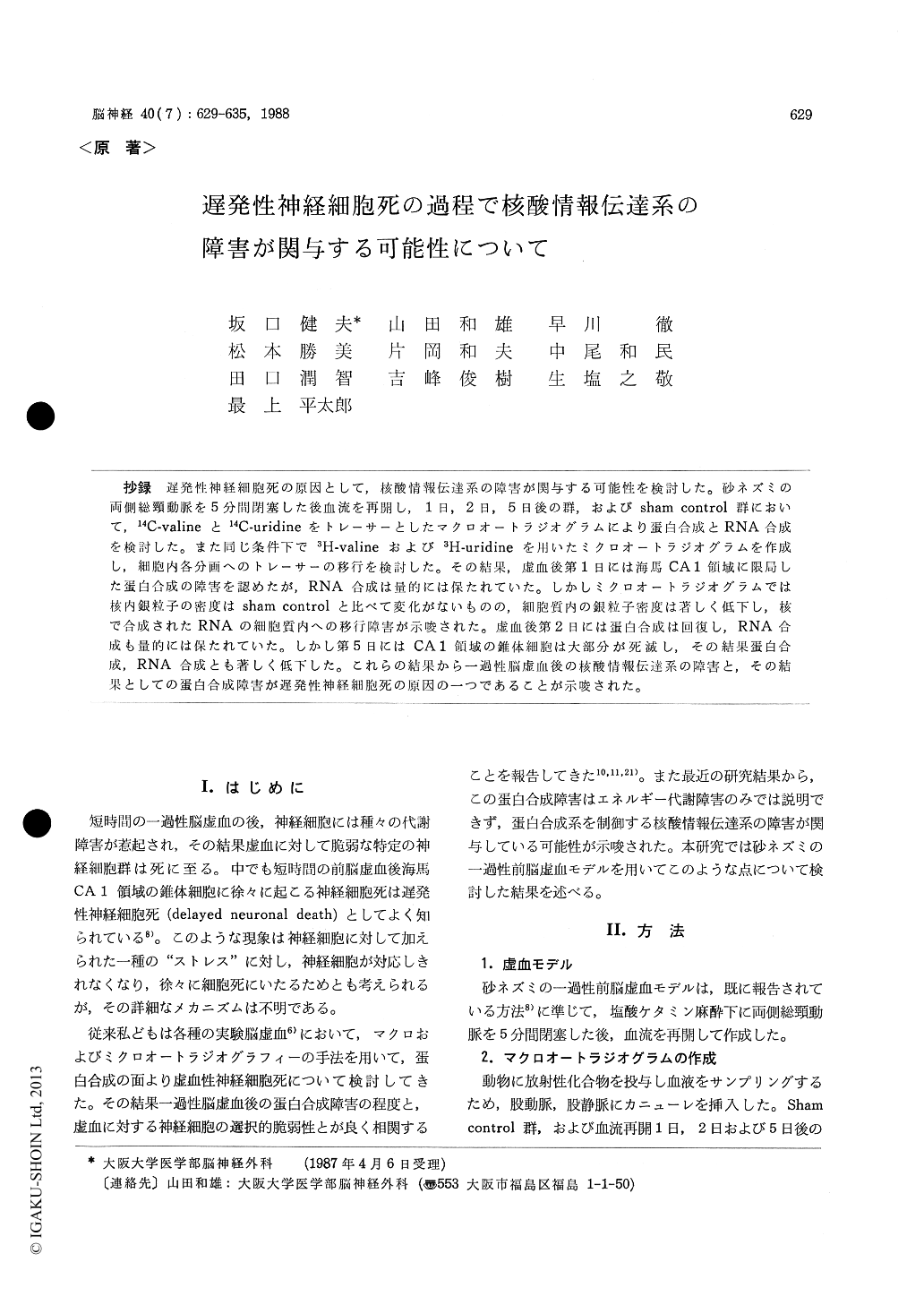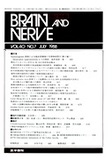Japanese
English
- 有料閲覧
- Abstract 文献概要
- 1ページ目 Look Inside
抄録 遅発性神経細胞死の原因として,核酸情報伝達系の障害が関与する可能性を検討した。砂ネズミの両側総頸動脈を5分間閉塞した後血流を再開し,1日,2日,5日後の群,およびsham control群において,14C-valineと14C-uridineをトレーサーとしたマクロオートラジオグラムにより蛋白合成とRNA合成を検討した。また同じ条件下で3H-valineおよび3H-uridineを用いたミクロオートラジオグラムを作成し,細胞内各分画へのトレーサーの移行を検討した。その結果,虚血後第1日には海馬CA1領域に限局した蛋白合成の障害を認めたが,RNA合成は量的には保たれていた。しかしミクロオートラジオグラムでは核内銀粒子の密度はsham controlと比べて変化がないものの,細胞質内の銀粒子密度は著しく低下し,核で合成されたRNAの細胞質内への移行障害が示唆された。虚血後第2日には蛋白合成は回復し,RNA合成も量的には保たれていた。しかし第5日にはCA1領域の錐体細胞は大部分が死滅し,その結果蛋白合成,RNA合成とも著しく低下した。これらの結果から一過性脳虚血後の核酸情報伝達系の障害と,その結果としての蛋白合成障害が遅発性神経細胞死の原因の一つであることが示唆された。
To clarify a possible cause of delayed neuronal death, synthesis of protein and ribonucleic acid (RNA) following transient forebrain ischemia was evaluated autoradiographically.
Mongolian gerbils were subjected to transient fore-brain ischemia for 5 minutes by occluding bilateral common carotid arteries. They were used for auto-radiographic study at 1, 2, and 5 days after ischemia. Tracer dose of 14C-valine or 14C-uridine was injected intravenously, and animals were sacrificed 45 minutes thereafter. Brains were frozen and thin sliced for macroautoradiography. After the first autoradiogram was obtained, tissue sections were incubated in cold 5% trichloroacetic acid for 1 hour, dried and again used for autoradiogram. With this preparation we could differentiate the tracer incorporated into pro-tein or RNA fraction from the total tissue radio-activity. In the different set of animals, microauto-radiograms of 3H-valine and 3H-uridine was obtained to detect subcellular distribution of synthesized protein or RNA.
At 1 day after ischemia, protein synthesis in theCA 1 region of the hippocampus was reduced by 57% of the sham control, but RNA synthesis was not reduced quantitatively. Microautoradiogram of 3H-uridine however, indicated that silver grains in the cytoplasms of the CA 1 pyramidal cells were much reduced as compared to sham controls, though the amount of silver grains in the nucleus was the same as sham controls. Therefore, synthesized RNA in the nucleus was not transported to the cytoplasm. At 2 days after ischemia, protein and RNA synthesis was preserved to the same level as sham controls. At5 days after ischemia, most of the pyramidal cells in the CA 1 region of the hippocampus were disappear-ed, and protein and RNA synthesis was reduced as a result of delayed neuronal death.
The results indicate that transport of synthesized nuclear RNA to the cytoplasm is disturbed in the CA 1 region of the gerbil hippocampus after transient forebrain ischemia. This malfunction of gene expres-sion may result in inhibition of protein synthesis and become in part a cause of delayed neuronal death.

Copyright © 1988, Igaku-Shoin Ltd. All rights reserved.


